Dealing With A Hoof Abscess
The Holistic Way
Hoof Abscesses are a common problem for horse owners which is often treated in an unnecessarily invasive and counter-productive way.
What Is An Abscess In The Hoof?
An abscess in the hoof is a localized infection in the sensitive structures of the hoof, within the hoof wall, which, as part of the body's response to the infection, results in a build-up of wast matter and white blood cells (pus). Normally such material is expelled from the body, but in the case of a hoof abscess, the hardness of the hoof wall and sole mean that the abscess must migrate to wherever it can escape from easily. This is usually either the horse's coronet band or the heel, but can occasionally be through a weak point in the sole or frog of the hoof.
Causes Hoof Abscesses
The internal infection of a hoof abscess can have many causes, one of the most common is a sudden onset of wet conditions (such as a lot of rain after a dry period). This change makes the hoof more vulnerable to bacteria migrating through the sole, wall or white line, and generating an infection.
Sometimes an abscess is caused by a puncture of the sole from a nail or other sharp object stepped on by the horse, or by a farrier mistakenly hammering a nail into the sensitive part of the hoof.
A hoof abscess can also come about for purely internal reasons. For example tissue within the hoof capsule may die as a result of poor blood flow or compression of the structures, resulting in a build-up of purulent matter. In our experience, such internally-caused abscesses are often part of a healing process in the hoof. They often take place after shoes have been removed and blood flow returns to the hoof, or as a part of a long-term recuperation of the healthy functioning of the hoof structures. As in any healing process, there are always waste materials to be cleared out, and in the hoof this often takes the form of an abscess.
For example, we have a horse who came to us at the age of four with very
poor hoof function manifesting in a dropping of the skeletal structures
inside the hoof capsule. In his case this was probably caused by poor
blood and nerve supply to the feet as a result of a serious spinal
injury in his wither. During his healing process this horse underwent
successive chronic abscesses in his feet during several years, causing mild to
sometimes more serious lameness. His feet have now transformed and show
healthy suspension and form.
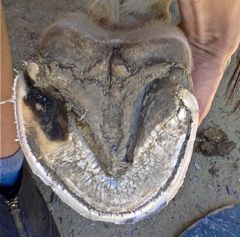
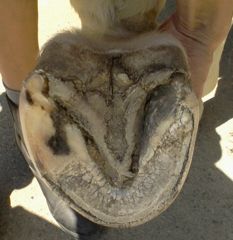
These photo shows one of this horse's worst abscesses, which developed over a long period, and eventually came out in the bar of his hind hoof. This abscess corresponded with a more general healing process in the foot, involving the whole internal suspensory mechanism.
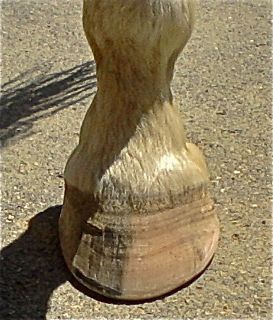
The abscess probably originated from a stress-fissure in the bar, which often form when the hoof begins to flex more than the old structure can handle. The left photo above shows the large eruption of infected material, and the corresponding deformation of the hoof form. The right-hand photo shows the same abscess after a trim and a minimal paring of the bar to remove excess material. The abscess was not dug out excessively, nor poulticed, and continued to drain and heal without a problem. This photo of the same hoof from the front shows the flaring and slight quarter crack on the right of the foot which are related to the abscess. The horizontal slit in the left-hand-side of the hoof wall is from a previous abscess that had grown down in the interim.
Signs of a Hoof Abscess
The first sign is always lameness, usually building up over several days, often to the point where the horse is reluctant to put any weight on the foot, or even touch it to the ground.
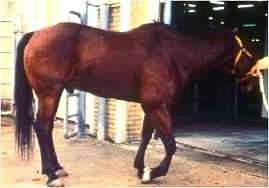
This acute pain is because the infection is trapped within the sensitive inner structures of the hoof, which has (in a healthy hoof) a lot of nerve supply. The trapped pus causes pressure on the nerves as it builds up, hence the acute pain. There is often a strong digital pulse accompanying an abscess, in addition to swelling around the fetlock joint and tendons. A horse with a hoof abscess may 'point' the foot to take the pressure of the heel area which has a greater nerve supply.
Hoof abscesses are not always acute however, and the more chronic, low-level version can be difficult to diagnose. Such a non-acute hoof abscess can go on developing for weeks, and the lameness may even come and go sometimes, or only be present when the horse walks on a hard surface or is ridden. How the horse reacts to an abscess also depends on his individual pain-tolerance threshold.
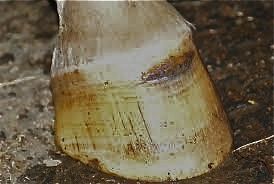
A low level abscess may resolve without bursting out at all, if the infection is dealt with and any purulence is absorbed by the body internally. Alternatively, such an abscess may burst out of the coronet band or heel without even being noticed until a horizontal crack grows down the hoof wall (photo, left).
Flaws in the Conventional Treatment of Hoof Abscesses
The conventional approach to abscesses is often intrusive and counter-productive. It usually involves a farrier or vet attempting to localize the infection by tapping on the sole, and then digging into the sole to let the pus escape. The problem with this method is that firstly, often the infection is not correctly localized, and secondly, the damage done to the sole breaches the integrity of the hoof capsule, with the possibility of directly introducing infection during the excavation, or leaving the hoof open to subsequent infection from matter entering the hole. It is not so rare that such an intervention results in an infection of the pedal bone - a serious and potentially life-threatening condition.
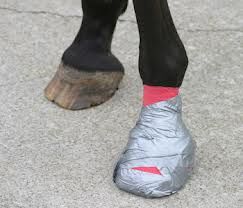
Once the hole has been dug, chemical poulticing is usually applied to draw out the abscess. The problem is that this may occur before the abscess was ready to be expelled, resulting in an insufficient cleansing of the hoof. Also the chemical drawing effect may disrupt the delicate biochemical balance of the hoof tissues.
Some vets may even give antibiotics to a horse with a hoof abscess. This is totally counter-productive, as it interrupts the body's own process of expelling the infectious material, and may result in a much more chronic, long-term infection, or simply an interruption of a healing process in the hoof. We should always remember, in addition that any synthetic drug, be it antibiotic, phenylbutazone (often given in the case of a hoof abscess to relieve pain) or even de-wormers, have damaging effects on the sensitive laminae of the hooves. This tissue serves as the 'glue' between the hoof wall and the internal structures of the hoof, and its feather-like cellular structure - full of blood - is very easily damaged by any toxic chemicals carried in the horse's blood stream. When the sensitive laminae are damaged, the hoof wall becomes deformed (hence the hoof distortion often caused by laminitis).
Dealing with Hoof Abscesses Holistically
Hoof Abscesses are one of the clearest examples of how we must trust the body's own capacity to deal with infection and healing processes. Instead of considering a hoof abscess as a nasty, evil poison that must be removed at all costs, we should look at is as a manifestation of the bodies beautiful and efficient way of handling infection and waste matter, collecting it first the and expelling it from the body at the right time and place.
We used to follow more-or-less the conventional approach to hoof abscesses, even though this involved a lot of inconvenience and stress. At the time we had horses living out in a wet climate, and when one developed a hoof abscess we dug it out and poulticed it, which involved having to wrap the hoof in dressing and a tyre inner-tube to keep the mud out (this was before the availability of poultice boots!). We then had to replace the poultice regularly until the abscess burst out.
At some point, however, we began letting nature take its course, allowing abscesses to develop and burst out naturally, with no further intervention other than Craniosacral Therapy to assist the body in the healing process and keep a healthy fluid and nerve supply to the affected foot. We have also found that homeopathy can also be very helpful for abscesses, we have used Hepar Sulf at a low potency to help the development and expulsion of the abscess (see this web page for some useful information of homeopathy for hoof care).
If the abscess was ever acute, and the horse had difficulty moving around, we would of course make sure that he/she had easy access to water and food, as as well as sufficient company. We found that the whole process of the abscess bursting out naturally did not actually take longer than doing it the conventional, intrusive way, and we have never had any complications as a result of letting the process happen naturally.
We must remember that the body has its own sophisticated intelligence when it comes to healing process, and abscesses are an example of a healing process which is normal, and is handled perfectly well by the body without the need for intrusive intervention.
Return from Healing A Hoof Abscess to the Happy Horse Training homepage
The pages on HHT are so wide-ranging and interrelated that we strongly recommend you look at the site plan to find other subjects that may interest you.
New from HHT!
AudioRide is a series of exercises designed to listen to while you ride.
Audio descriptions guide you through each step of developing a balanced, dynamic connection with the horse through your position.
This truly innovative learning tool gives you a whole new way of being guided in your riding, in a calm, clear, step-by-step way.
Free Download! Introductory Exercise: Riding in the Now
The Gymnastic Rider eBook
Now available exclusively from HHT!
A unique, comprehensive guide to practical rider biomechanics. This professionally produced eBook takes the rider through the process of developing their body in the specific way that brings the horse's movement into harmony and balance, without force and constraint. Click here for full details, and to download the 15-page introduction to the book for free.
Join the Happy Horse Training group on Facebook!
See and share topical info, news and photo's, and take part in lively discussions.
Click here to go to the HHT group (make sure you log into fb first) and then click on the 'join' button at the top of the page.
Join the Whole Horse Newsletter!
HHT's free monthly newsletter giving you wide-ranging and intelligent insights into holistic horsemanship.
Just enter your details below to join.
Free bonus on the riding position with all new subscriptions: Ten Top Tips To Instantly Improve Your Connection With Your Horse.
Click here to see back issues of The Whole Horse newsletter
Train Your Horse
The Holistic Way
How To Train A Horse Without Force
is a unique guide to training horses through energetic connection and
gymnastic training. Part 1 covers everything on the ground, from
handling to the lungeing technique that develops strength, straightness
and engagement. Comes with a free eBook supplement on Horse Trauma.
Click here for more details.
"As a student of Zen Buddhism for nearly three decades, I've often wondered when someone was going to write the book on Zen and the art of horsemanship, and I think that your emphasis on mindfulness and energy connection gets right at the heart of the matter."
- Prof. Teresa Lloyd, U.S.
Do You Have
A Horse Story
To Share On HHT?
So many people have been through
wonderful experiences with horses, whether in training or otherwise. If
you've made a change in a horse's life - or one has made a change in
yours - tell us about it here.
Learn The Natural Barefoot Trim - The Simple Way
The Simple Seven-Step Natural Trim is a comprehensive step-by-step guide to a cutting-edge barefoot trim. Click here to find out more.
What people say about HHT:
"The riding instruction is outstanding, if instructors in the UK taught this way there would be a lot of happy riders and horses."
"The riding tuition exceeded my hopes and expectations by a long way; giving me an exciting new facet to horsemanship which is lighter. more subtle, more elegant and more meaningful. It is as if a new door has opened bringing more sunlight and air."
"My goodness - what a change has taken place in my riding. I think that I'm starting to sit 'into' the horse rather than on top of him. I felt my horse's movements in a way that has almost never happened before"
Click on Testimonials for more





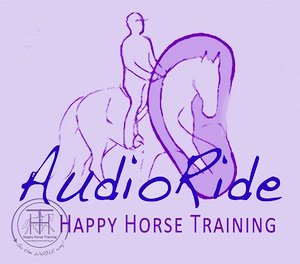




New! Comments
Anything to say about this page? Leave your comment in the box below.